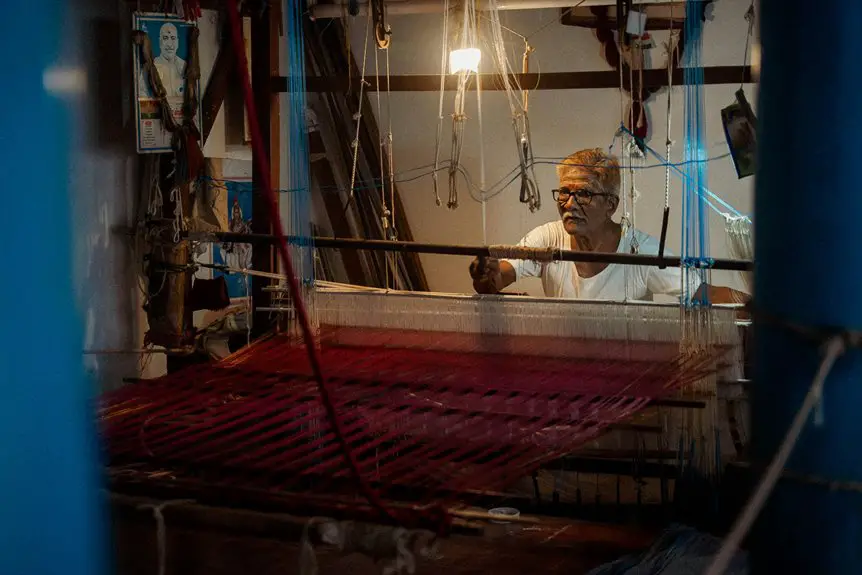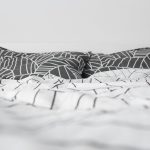Polycotton fabric is a solid choice if you want durability, softness, and easy care without breaking the bank. It combines polyester’s strength with cotton’s comfort, resists wrinkles and shrinking, and dries quickly. However, it’s less breathable than pure cotton and has environmental drawbacks due to its synthetic content. You’ll enjoy its versatility in fashion and home items, plus cost savings. Keep exploring to uncover all the pros and cons before you decide.
Table of Contents
Key Takeaways
- Polycotton offers strong durability, resisting tearing, shrinking, and stretching for long-lasting use in clothing and home textiles.
- It provides moderate comfort with a smooth texture but is less breathable and moisture-absorbent than pure cotton.
- The fabric is easy to care for, machine washable, wrinkle-resistant, and dries faster than cotton.
- Polycotton has environmental drawbacks due to synthetic polyester, including microplastic pollution and reduced biodegradability.
- It is versatile and cost-effective, suitable for fashion and home applications while maintaining vibrant colors and shape.
Durability and Strength of Polycotton Fabric
Although you mightn’t realize it at first, polycotton fabric offers impressive durability and strength that can handle everyday wear and tear.
When you choose polycotton, you get a blend of polyester’s resilience and cotton’s sturdiness, making it less prone to ripping or fraying compared to pure cotton. You won’t have to worry about your clothes or linens wearing out quickly, even after multiple washes.
Polycotton resists shrinking and stretching, so your items keep their shape longer. If you need fabric that stands up to frequent use without losing integrity, polycotton is a smart pick.
Its reinforced fibers make it tough enough for everyday items like shirts, bed linens, and uniforms, giving you lasting value and reliable performance.
Comfort and Breathability Compared to Pure Cotton
When you wear polycotton, you might notice it feels softer or sometimes less soft than pure cotton, depending on the blend.
You’ll also want to take into account how well it lets air flow and manages moisture throughout the day.
These factors play a big role in how comfortable you’ll feel in different conditions.
Softness and Skin Feel
Softness plays a key role in how comfortable your clothing feels against your skin, and polycotton blends offer a unique balance.
Unlike pure cotton, which is naturally soft and gentle, polycotton incorporates polyester fibers, making the fabric slightly less plush. However, this blend gives you a smoother texture that resists wrinkling and maintains shape better than 100% cotton.
You might notice polycotton feels a bit less breathable, but it usually stays comfortable throughout the day. If you have sensitive skin, pure cotton tends to be more hypoallergenic, but many people find polycotton soft enough for everyday wear without irritation.
Ultimately, polycotton delivers a fabric that’s soft, durable, and easy to care for, striking a practical middle ground between comfort and resilience.
Airflow and Moisture Control
Beyond how polycotton feels against your skin, its ability to manage airflow and moisture greatly impacts your comfort.
Polycotton blends cotton’s breathability with polyester’s durability, but this mix affects airflow. You’ll notice that pure cotton allows more air to circulate, keeping you cooler in hot weather. Polycotton, however, traps some heat due to polyester’s tighter fibers, which might make you feel warmer.
When it comes to moisture, cotton excels at absorbing sweat and letting it evaporate, helping you stay dry.
Polycotton absorbs less moisture but dries faster because polyester repels water. So, if you want quick-drying fabric with moderate breathability, polycotton works well.
But for maximum airflow and moisture absorption, pure cotton still has the edge.
Easy Care and Maintenance Benefits
Although some fabrics demand special attention, polycotton stands out because it’s incredibly easy to care for. You’ll appreciate how it combines the best of cotton and polyester, making maintenance straightforward without sacrificing comfort.
Here are three easy care benefits you’ll enjoy:
- Machine Washable: You can toss polycotton garments in the washing machine without worrying about damage or special cycles.
- Quick Drying: Thanks to the polyester content, polycotton dries faster than pure cotton, saving you time.
- Color Retention: Polycotton resists fading well, so your clothes will keep their vibrant look longer, even after repeated washes.
With these benefits, polycotton lets you spend less time on laundry and more on what you love.
Resistance to Wrinkles and Shrinkage
When you choose polycotton, you benefit from a fabric that resists wrinkles and shrinkage better than pure cotton. This blend maintains its shape and smooth appearance after washing, so you won’t spend as much time ironing. While it’s not completely wrinkle-proof, it holds up well in everyday wear and laundering. Additionally, polycotton shrinks less, helping your clothes keep their original fit longer.
| Feature | Polycotton vs. Cotton |
|---|---|
| Wrinkle Resistance | Polycotton wrinkles less |
| Shrinkage | Polycotton shrinks minimally |
| Maintenance | Easier to manage wrinkles |
| Longevity | Better shape retention |
Choosing polycotton means less hassle keeping your wardrobe neat and comfortable.
Environmental Impact and Sustainability Concerns
How does polycotton impact the environment compared to other fabrics?
When you choose polycotton, you’re opting for a blend that combines natural and synthetic fibers, which affects sustainability in several ways:
Choosing polycotton means blending natural and synthetic fibers, influencing environmental sustainability in multiple ways.
- Resource Use – Polycotton requires less water than pure cotton but relies on petroleum-based polyester, a non-renewable resource.
- Microplastic Pollution – Washing polycotton releases microplastics into waterways, contributing to environmental pollution.
- Biodegradability – Unlike 100% cotton, polycotton doesn’t biodegrade easily due to its synthetic content, leading to longer landfill persistence.
Cost-Effectiveness and Affordability
You’ll find polycotton is a budget-friendly fabric that balances cost and quality.
Choosing it can save you money over time thanks to its durability and easy care.
Let’s compare its price with other fabrics to see how it stacks up.
Budget-Friendly Material Choice
Although you might prioritize quality, polycotton stands out as a budget-friendly fabric that balances cost and durability. Choosing polycotton means you don’t have to sacrifice performance for price, making it a smart option for everyday use.
Here’s why polycotton is a budget-friendly material choice:
- Lower production costs: Combining polyester with cotton reduces manufacturing expenses, which translates to more affordable prices for you.
- Wide availability: Polycotton’s popularity guarantees competitive pricing and easy access in various blends and weights.
- Versatility: You get a fabric suitable for multiple uses—from clothing to bedding—helping you avoid buying different specialty fabrics.
This mix of affordability and practicality makes polycotton a fabric worth considering when you want value without overspending.
Long-Term Expense Savings
Investing in polycotton fabric can save you money over time by reducing the need for frequent replacements and special care. Its durability means fewer tears and less wear, while its easy maintenance cuts down on costly dry cleaning or delicate washing. You’ll spend less on repairs and enjoy longer-lasting garments or bedding. Here’s a quick comparison to highlight the savings:
| Feature | Polycotton | Pure Cotton |
|---|---|---|
| Durability | High | Moderate |
| Maintenance Cost | Low (machine-washable) | Higher (special care) |
| Replacement Rate | Low | Higher |
Price Comparison With Alternatives
Many shoppers find polycotton fabric offers a more budget-friendly option compared to pure cotton and synthetic blends.
When you’re comparing prices, consider these points:
- Initial Cost: Polycotton usually costs less upfront than 100% cotton, making it easier on your wallet at purchase.
- Durability: Since polycotton resists wrinkles and tears better than pure cotton, you won’t have to replace items as often, saving money over time.
- Maintenance: It requires less care than cotton, reducing your expenses on detergents and energy for washing and ironing.
Versatility in Fashion and Home Applications
Polycotton fabric offers remarkable versatility that suits both fashion and home applications.
When you choose polycotton, you get a material that adapts well to various clothing styles, from casual shirts to dresses, thanks to its balanced blend of comfort and durability. It holds colors beautifully, so your garments stay vibrant wash after wash.
At home, polycotton works wonders for bedding, curtains, and upholstery, combining softness with ease of care. You don’t have to worry about frequent ironing or shrinking, which makes maintenance simple.
Whether you’re updating your wardrobe or revitalizing your living space, polycotton provides you with a reliable, practical option that meets diverse needs without sacrificing style or function.
It’s a smart choice if you want flexibility without compromise.
Frequently Asked Questions
How Does Polycotton Fabric React to Dyes and Colors?
Imagine a canvas that welcomes both watercolors and oils—polycotton fabric soaks up dyes evenly, but you might notice colors slightly softer compared to pure cotton. You’ll enjoy vibrant, lasting hues with a gentle touch.
Is Polycotton Fabric Hypoallergenic?
You might find polycotton fabric less hypoallergenic than natural fibers since it contains polyester, which can irritate sensitive skin. However, many people wear it comfortably, so it really depends on your individual allergies and skin sensitivity.
Can Polycotton Fabric Be Used for Outdoor Gear?
You can use polycotton fabric for outdoor gear since it’s durable and breathable. However, it’s not fully waterproof or as moisture-wicking as specialized fabrics, so you might want to combine it with other materials for better performance.
How Does Polycotton Hold up in Extreme Weather Conditions?
You’ll find polycotton resists wrinkles and dries faster than cotton, but it’s less breathable in extreme heat and can degrade under intense UV exposure. It handles cold okay but isn’t ideal for heavy rain or snow.
Are There Any Special Washing Instructions for Polycotton Blends?
When washing polycotton, you’ll want to treat it like a delicate dance—use cold water, gentle cycle, and mild detergent. Avoid bleach and high heat in the dryer to keep its blend smooth and long-lasting.
- Is Chenille a Woven or Nonwoven Fabric? - July 11, 2025
- How to Tell if Fabric Is Woven or Nonwoven - July 10, 2025
- The Complete Guide to Nonwoven Materials - July 10, 2025







